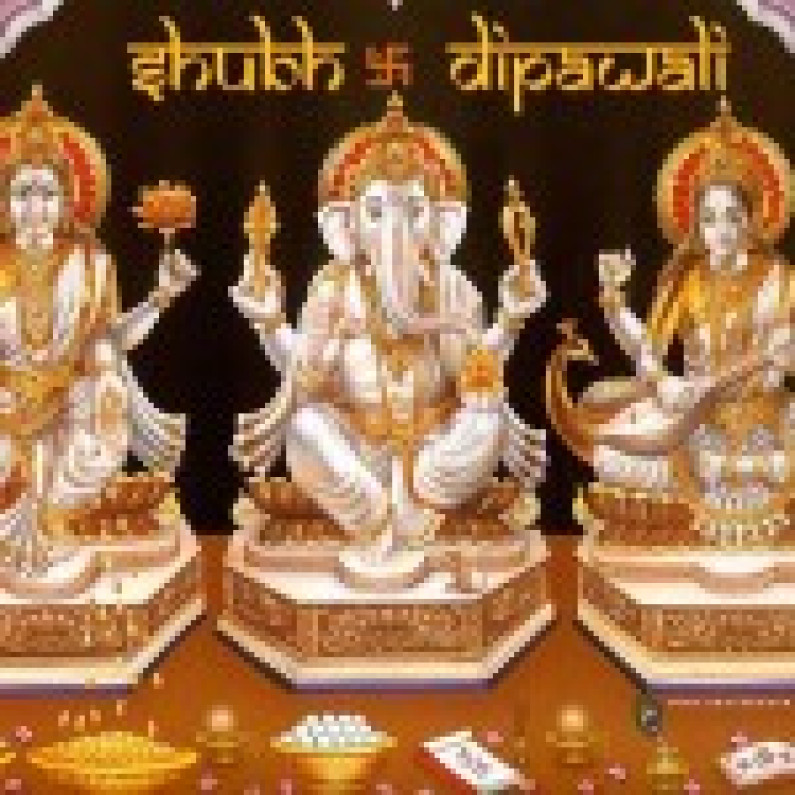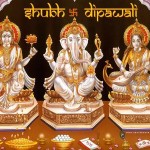
 Diwali is the festival of lights as we all know. It is one of the biggest festivals in the country of India. It is celebrated all across the country with great enthusiasm, people from all casts and parts of the country actively participate in this beautiful festival. It can also be considered as the Christmas of India. All the shops and houses are decorated with lights. However, the pooja that is done on this day differs in style from one part of the country to the other. We will give you a slight idea of the Diwali pooja vidhi and how it is done in various parts of the country.
Diwali is the festival of lights as we all know. It is one of the biggest festivals in the country of India. It is celebrated all across the country with great enthusiasm, people from all casts and parts of the country actively participate in this beautiful festival. It can also be considered as the Christmas of India. All the shops and houses are decorated with lights. However, the pooja that is done on this day differs in style from one part of the country to the other. We will give you a slight idea of the Diwali pooja vidhi and how it is done in various parts of the country.
Diwali Pooja Vidhi In North India
In Diwali pooja vidhi in the northern region, the goddess Laksmi is worshiped for wealth and prosperity. In the eastern parts of the country the goddess kali is worshiped for strength and to fight evil. Even Ganesha is worshiped in many parts of the country. He is considered to be Siddhi Vinayak. As a result he ensures that all the work that we are doing ends in success. We will now try to discuss a little bit on Diwali pooja vidhi all across the country and the significance too.
East India Vidhi
Diwali pooja vidhi in the eastern parts of the country is a little different from the rest as they worship the goddess kali. She is considered to be one of the various forms of Parvati the goddess of Shakti or strength. She is worshiped to do away with the evil forces and to make the world a better place to live in. All households clean their homes. Throw away all old and useless things. This makes the environment of the house better and gives positive energy to the house.
Kali puja is done in the houses as well as people get together and do the puja. The puja is mostly at night. People do fast the whole day only to do the puja in the evenings. Bali that is sacrifice is still performed in some parts of this area. It is done to please the goddess. Most a goat is killed as an offering to the goddess.
Laxmi Poojan
In the northern parts of India the goddess of wealth Laksmi is worshiped. The houses are made neat and clean. This is to ensure that the goddess is welcomed to a new and fresh house. The belief is that goddess Laksmi does not reside in dirty houses. There is an interesting custom wherein the broom is worshiped. This too also signifies how important cleaning is during this festival. Haldi and kumkum (that means turmeric and vermillion) are very closely associated with this festival. The goddess is offered this before the puja begins. It is put on the forehead of the goddess before any ceremony begins.
The Lord Ganesha as mentioned earlier is worshiped before any good task starts. This is exactly why in the entrance of any temple Ganesha’s idol is kept before all other gods. Similarly on Diwali Ganesha is often worshiped even before goddess Laksmi. After this the lamps are lit and put all across the house. This is also a part of the Diwali pooja vidhi. Even a corner of the house should not be in dark before you start the pooja. This is a gesture to well come the gods to your house. Then the aarti begins with lamps and bells. Some also sing songs to worship the goddess. The whole family must stand together and pray. This is also called the aarti. Some people who know the Diwali pooja vidhi do it themselves. Some also hire learned and educated pundits to do this puja.
Lakshmi Ji Katha
After the pooja some houses also have Laksmi ji ki katha path. Katha is a collection of stories that are associated with the goddess Laksmi and how she helped people who believed her. These katha is read by the women of the family. Some people also visit the temples are worship the goddess.
DIY Diwali Pooja Vidhi
In case you are planning to do the Diwali puja at home and you don’t know the vidhi or how to do Diwali Puja, dont worry. Let us tell you how to do it in simple steps. First let us tell you the things that you will need.
Well you need the idol or pictures of Laksmi and Ganesha. Kumkum, haldi, ten piece of supari, chandan and kesar, agarbatti, rice, honey, a neat piece of cloth and some sweets for prasad. You will also need a pot filled with water, some fruits, milk, honey, curd, ghee and sugar, gulal, two coconuts. You will also need flowers. You can use them to decorate your house too. For the exact quantities of these please read the Diwali pooja Vidhi mentioned below. If you want to follow vastu then do remember that the Laksmi and Ganesha idol should face North and North West direction. Even North East can be a good option. The idols or pictures should be at least eight to nine inches in length. Rangoli is a very important part of the festival. You must apply some in the main entrance of the house and also make small steps of the goddess. This will welcome the goddess and also gives a festive feel to the house. The exact time Diwali pooja keeps changing. Please consult a well educated pundit and get the exact time to start the puja. However, you can do the arrangement of the puja before and keep. This year in 2012 the time is between 6:00 PM to 9:00 PM in the evening on the 13th November.
Now let’s discuss the simple steps that you need to follow for the puja. The place where you do the pooja must be first covered with a red colour fresh cloth. You must keep lord Ganesha, Laksmi and if possible Sarawati (the goddess of knowledge) on this cloth. Some people keep the idol of Saraswati and some don’t. However, the concept is good how you can have wealth without knowledge. Knowledge and intelligence in any form is required to make wealth and also to make it grow. Then place nine mounts of rice on this cloth. These none mounts signify the nine planets. Each mount must have a supari on it. After this is done take some water on your left palm and put it on your head as a process to purify yourself before you do the pooja. The next step in Diwali pooja vidhi is to call out your own name and the name of all the people who are present at the puja and take a sankalp. You must tell the gods that you are doing the puja to please the goddess laksmi and Narayan (he is considered to be the husband of goddess Laksmi. After this light the ghee lamps and light the agarbatti.
We now start with the exact Diwali pooja vidhi. First put a Supari in front of the lord Ganesha. You must offer the flowers and rice. Then start chanting the Ganesha shlokas. By this you are saying the lord to remove all obstacles from your path. The shloka as we all know is as follows:
Jai Ganesh Jai Ganesh Jai Ganesh deva, Mata jaki Parvati, pita maha deva, Ek dant dayavant, char bhuja dhari, Mathe Sindur sohai, muse ki savari, Jai Ganesh Jai Ganesh Jai Ganesh deva. Andhan ko aakh det, kodhin ko kaya, Ganesh ko pura det, nirdhan ko maya, pan chade, phul chade, aur chade mewa, laddu ka bhog lage, saath kare seva, Jai Ganesh Jai Ganesh deva, Mata jaki Parvati, pita maha deva.
After this the next thing you need to do in Diwali pooja vidhi is to fill a pot with water, put mango leaves on it before you keep it in front of the god. The kalash needs to be tied with a red cloth around its neck. Place a coconut on top of it. A swastika must be drawn on the pot with kumkum. This signifies universal power. After the pot is set you will have to place flowers in front of all the gods. You must put turmeric tika on all the god’s foreheads. You can offer fruits and sweets to the gods. You can also keep gold and silver coins near the goddess laksmi as a sign of prosperity that she is bringing to the house. Sprinkle water on all four directions to purify the four directions of the universe. Now we move on to the most important part of Diwali pooja vidhi. This is called the Panchmrit abhishek of lord Narayan and Laksmi. It is prepared by combining milk, honey, curd, ghee and sugar.
These five items make the most important offering to the god known as Panchmrit. The coins must be soaked in milk. Then wash them with water and apply gulal (a red colour powder). In a thali place the coin and decorate it with flowers. One of the two coconuts you must break at this point and offer to the gods. Now you can offer sweets to goddess laksmi and start to recite the laksmi shloka. The shloka is like this – jay laksmi mata, maiya jai laksmi mata, tumko nish din dhyawat, har Vishnu vidhata, brmhani, shrudrani, kamal, tu hi jag mata, surya dhyawat, narad rishi gatha, jai laksmi mata. This will welcome the goddess to your house and ensure prosperity. This is a very vital part of the Diwali pooja Vidhi.
After the puja is over you can throw all the things that you used in water. However, the idol of Saraswati, Ganesha and Laksmi must be preserved for a year. Next year after you get new idols only then throw away these old idols either in the holy water of Ganges or you can also throw them in the water of any pond that is near to your house.
This is more or less all about the Diwali pooja vidhi that is followed all over the country. These steps must be followed well to ensure that the year goes on well and you are blessed. It is an auspicious day and everyone participate in the pooja actively and with great devotion. Apart from the pooja people also exchange gifts and goodies. The families come together as the schools and offices are mostly closed. People visit each other’s houses. Good food and sweets are prepared. In India no matter what part of the country you are a festival will always be incomplete without good food.